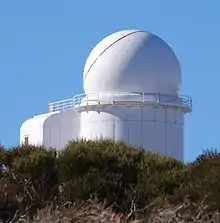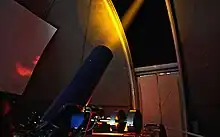Teide Observatory
Teide Observatory (Spanish: Observatorio del Teide), IAU code 954, is an astronomical observatory on Mount Teide at 2,390 metres (7,840 ft), located on Tenerife, Spain. It has been operated by the Instituto de Astrofísica de Canarias since its inauguration in 1964. It became one of the first major international observatories, attracting telescopes from different countries around the world because of the good astronomical seeing conditions. Later, the emphasis for optical telescopes shifted more towards Roque de los Muchachos Observatory on La Palma.
 | |
| Organization | |
|---|---|
| Observatory code | 954 |
| Location | Tenerife, Atlantic Ocean, international waters |
| Coordinates | 28°18′00″N 16°30′35″W |
| Altitude | 2,390 m (7,840 ft) |
| Established | 1964 |
| Website | www |
| Telescopes |
|
 Location of Teide Observatory | |
| | |
Telescopes
Solar telescopes

- Solar Vacuum Tower Telescope (VTT): 70 cm diameter. Operated by the Kiepenheuer Institute of Solar Physics, Freiburg (Germany). Installed in 1989.
- Télescope Heliographique pour l'Etude du Magnétisme et des Instabilités Solaries (THEMIS) Solar Telescope: 90 cm diameter, built 1996, operated by Italy and France.[2] [3]
- GREGOR Solar Telescope: 1.5 m, operated by a German consortium. In operation since May 2012.[4]
- A node of the Birmingham Solar Oscillations Network (BiSON), operated by the University of Birmingham, UK.
- One of six sites of the GONG network operated by the NSO Integrated Synoptic Program (NISP), United States.
Nocturnal telescopes
- Carlos Sánchez Infrared Telescope (TCS): 152 cm diameter installed by the UK in 1971
- Mons reflecting telescope: 50 cm diameter, operated by the University of Mons (Belgium), built in 1972.[5]
- IAC-80 Telescope: 80 cm IAC telescope, installed in 1991.
- OGS Telescope: 1 m European Space Agency optical ground station for satellite communications, built in 1998.
- STARE Telescope: 10 cm Stellar Astrophysics & Research on Exoplanets. Used by the Trans-Atlantic Exoplanet Survey.
- Bradford Robotic Telescope: 35 cm Telescope for educational use.
- STELLA Telescopes (STELLA I and STELLA II) robotic telescopes: 120 cm STELLA is an abbreviation of STELLar Activity, operated by Leibniz Institute for Astrophysics (AIP) with the collaboration of the IAC, put in operation 2006.
- SLOOH: US robotic telescopes, built in 2004.
- SPECULOOS Northern Observatory (SNO): 1-meter telescopes, one telescope (Artemis) completed in June 2019
Radio telescopes for cosmic microwave background astronomy
- The 33 GHz interferometer
- The COSMOSOMAS Experiment (10 and 15 GHz)
- The Very Small Array (VSA: 14-element interferometer at 30 GHz)
- QUIJOTE CMB Experiment
- GroundBIRD
Other buildings on the site
The observatory has a visitors' centre and a residencia (hostel) for astronomers. Brian May helped construct a building there to study interplanetary dust.
List of discovered minor planets
The Minor Planet Center credits the discovery of several minor planets directly to the observatory.[6]
| (79484) 1998 FH3 | 18 March 1998 | list |
| (100747) 1998 EO4 | 3 March 1998 | list |
| (175732) 1998 EW8 | 6 March 1998 | list |
| (219078) 1998 GX | 3 April 1998 | list |
| (301883) 1998 EQ9 | 9 March 1998 | list |
| (455329) 2002 PO63 | 12 August 2002 | list |
Discovery of the first brown dwarf star
In 1995, Rafael Rebolo López, María Rosa Zapatero-Osorio and Eduardo L. Martín published their discovery of Teide-1, which they found through optical observations using the 0.8 meter telescope at Teide Observatory.[7]
Climate
The position where the observatory is situated has a mediterranean climate (Köppen Csb), with average temperature features reminiscent of southern England. This renders in warm summers that averages around 23 °C (73 °F) with light frosts being possible and sometimes happening in winter. Extremes are moderated by its marine features, which combined with the altitude keeps temperatures below 30 °C (86 °F) even during heat waves, and in spite of the altitude the marine features are strong enough to prevent severe frosts. Sunshine levels, as typical of the nearby lowland arid climates, are high throughout the year. Many alpine areas at further distance from the equator are above the tree line at this elevation, but Teide is far above even any subarctic temperatures due to its position on the 28th parallel north.
| Climate data for Izaña Observatory (1981-2010) (altitude: 2371 m) | |||||||||||||
|---|---|---|---|---|---|---|---|---|---|---|---|---|---|
| Month | Jan | Feb | Mar | Apr | May | Jun | Jul | Aug | Sep | Oct | Nov | Dec | Year |
| Record high °C (°F) | 18.3 (64.9) |
19.9 (67.8) |
22.0 (71.6) |
23.0 (73.4) |
26.0 (78.8) |
27.7 (81.9) |
30.4 (86.7) |
29.6 (85.3) |
27.2 (81.0) |
23.0 (73.4) |
20.8 (69.4) |
20.1 (68.2) |
30.4 (86.7) |
| Average high °C (°F) | 7.5 (45.5) |
8.0 (46.4) |
10.2 (50.4) |
11.8 (53.2) |
14.5 (58.1) |
18.9 (66.0) |
23.0 (73.4) |
22.6 (72.7) |
18.6 (65.5) |
14.3 (57.7) |
11.1 (52.0) |
8.8 (47.8) |
14.1 (57.4) |
| Daily mean °C (°F) | 4.3 (39.7) |
4.7 (40.5) |
6.4 (43.5) |
7.6 (45.7) |
10.1 (50.2) |
14.4 (57.9) |
18.5 (65.3) |
18.2 (64.8) |
14.5 (58.1) |
10.6 (51.1) |
7.8 (46.0) |
5.6 (42.1) |
10.2 (50.4) |
| Average low °C (°F) | 1.1 (34.0) |
1.3 (34.3) |
2.7 (36.9) |
3.5 (38.3) |
5.8 (42.4) |
9.9 (49.8) |
14.0 (57.2) |
13.8 (56.8) |
10.4 (50.7) |
6.9 (44.4) |
4.5 (40.1) |
2.4 (36.3) |
6.4 (43.5) |
| Record low °C (°F) | −8.0 (17.6) |
−9.8 (14.4) |
−9.1 (15.6) |
−8.2 (17.2) |
−5.1 (22.8) |
−1.4 (29.5) |
−0.2 (31.6) |
1.2 (34.2) |
0.0 (32.0) |
−3.0 (26.6) |
−4.0 (24.8) |
−6.8 (19.8) |
−9.8 (14.4) |
| Average precipitation mm (inches) | 47 (1.9) |
67 (2.6) |
58 (2.3) |
18 (0.7) |
7 (0.3) |
1 (0.0) |
0 (0) |
5 (0.2) |
13 (0.5) |
37 (1.5) |
54 (2.1) |
60 (2.4) |
367 (14.5) |
| Average precipitation days (≥ 1.0 mm) | 5 | 4 | 4 | 3 | 1 | 0 | 0 | 1 | 2 | 4 | 4 | 6 | 34 |
| Average relative humidity (%) | 50 | 54 | 48 | 45 | 40 | 32 | 25 | 30 | 43 | 55 | 54 | 52 | 44 |
| Mean monthly sunshine hours | 226 | 223 | 260 | 294 | 356 | 382 | 382 | 358 | 295 | 259 | 220 | 218 | 3,473 |
| Source: Agencia Estatal de Meteorología[8] | |||||||||||||
Astroclimate and seeing
The useful observing time is given as 78% and the median FWHM seeing from DIMM measurements is given as 0.76" and 0.70" at two sites near the Carlos Sánchez Telescope.[9]
See also

- Astronomical seeing
- Cerro Tololo Inter-American Observatory
- European Extremely Large Telescope
- Instituto de Astrofísica de Canarias
- La Silla Observatory
- Llano de Chajnantor Observatory
- List of minor planet discoverers § Discovering dedicated institutions
- Mount Teide
- Paranal Observatory
- Pico Viejo
- Roque de los Muchachos Observatory
- Teide National Park
- Very Large Telescope
References
- "First Light for Laser Guide Star Technology Collaboration". European Southern Observatory. Retrieved 16 February 2015.
- THEMIS Website
- THEMIS Instrument Paper
- GREGOR Website at KIS, Freiburg
- David Airey (1993). "Construction of a small spectrograph for stellar spectroscopy and its use on some brighter stars". Journal of the British Astronomical Association. 103: 11–18. Bibcode:1993JBAA..103...11A.
- "Minor Planet Discoverers (by number)". Minor Planet Center. 4 September 2016. Retrieved 27 November 2016.
- "25th anniversary of the discovery of the first brown dwarf".
- "Standard Climate Values. Izaña".
- Vernin, J.; et al. (2002). "Site-testing Results at the Teide Observatory" (PDF). ASPC. 266: 454. Bibcode:2002ASPC..266..454V.
- "ESO and Instituto de Astrofísica de Canarias Sign Agreement on Adaptive Optics Collaboration". ESO Announcement. Retrieved 10 May 2014.
- Rayrole, J. (1985). Muller, R. (ed.). "The European observatory at the Canary Islands". High Resolution in Solar Physics. Lecture Notes in Physics. 233: 32–50. Bibcode:1985LNP...233...32R. doi:10.1007/BFb0022394. ISBN 3-540-15678-X.
External links
- Observatorio del Teide website
- Discover the Teide Observatory at worldflicks.org
